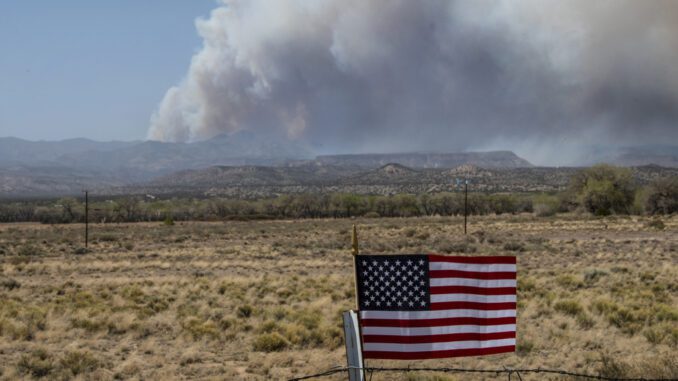
SANTA FE, N.M. — The U.S. Forest Service’s own prescribed burn started a sprawling 2022 wildfire that nearly reached Los Alamos, New Mexico, the agency acknowledged Monday in a report published after a lengthy investigation.
The Cerro Pelado fire burned in dry, windy conditions across more than 60 square miles and crept within a few miles of the city of Los Alamos and its companion U.S. national security lab. As the fire approached, schools closed and evacuation bags were packed before the flames tapered off.
Investigators traced the wildfire to a burn of piles of forest debris commissioned by the Forest Service. The burn became a holdover fire, smoldering undetected under wet snow, with no signs of smoke or heat for months, said Southwestern Regional Forester Michiko Martin.
The revelation prompted immediate rebukes against the Forest Service by New Mexico political leaders, including Gov. Michelle Lujan Grisham. She said she was “outraged over the U.S. Forest Service’s negligence that caused this destruction.” Episodes of extremely hot and dry weather in recent years have triggered concerns about prescribed burns as techniques for clearing forest debris, concerns that Grisham echoed.
The federal government already has acknowledged that it started the largest wildfire in state history, whichcharred more than 530 square miles of the Rocky Mountain foothills east of Santa Fe, New Mexico, destroying homes and livelihoods.
The Forest Service last spring halted all prescribed burn operations for 90 days while it conducted a review of procedures and policies. By the end of the moratorium, managers learned that they can’t rely on past success, and must continuously learn and adapt to changing conditions, Forest Service Chief Randy Moore recently told New Mexico lawmakers.
Firefighters now monitor pile burns using handheld thermal devices and drones that can detect heat, Martin said Monday.
Examples of prescribed burns that escaped control include the 2000 Cerro Grande Fire that swept through residential areas of Los Alamos and across 12 square miles of the laboratory — more than one-quarter of the campus. The fire destroyed more than 230 homes and 45 structures at the lab. In 2011, a larger and faster-moving fire burned fringes of the lab.
In the spring of 2022, wildfires were propelled by ferocious winds across Arizona and New Mexico, combined with extreme drought and warm temperatures, casting a pall of smoke across the region.
U.S. Sen. Martin Heinrich urged the Forest Service to be more nimble in its investigations and decisions.
“The warming climate is making our forests more vulnerable to catastrophic wildfires. That’s a reality that our Forest Service can and must urgently respond to when deciding when and how to do prescribed burns,” he said in a statement. “We cannot catch up to this reality if it takes nearly a year to even make the findings on the Cerro Pelado Fire public.”
An initial probe into the origin of the Cerro Pelado fire was conducted by a wildland fire investigator from Washington state’s Department of Natural Resources and pointed toward an ash pit from the earlier prescribed burn as the likely source, while ruling out other potential sources such as campfires and lightning. But it stopped short of a definitive conclusion.
The Forest Service commissioned a second investigation by its own special agents and concluded that the prescribed burn and its windblown embers were the cause.
The Biden administration is trying to confront worsening wildfires in the U.S. West through a multi-billion dollar cleanup of forests choked with dead trees and undergrowth. Chainsaws, heavy machinery — and controlled burns — are major components of the effort, with Congress in the last two years approving more than $4 billion in new funding to prevent repeats of destructive infernos.
